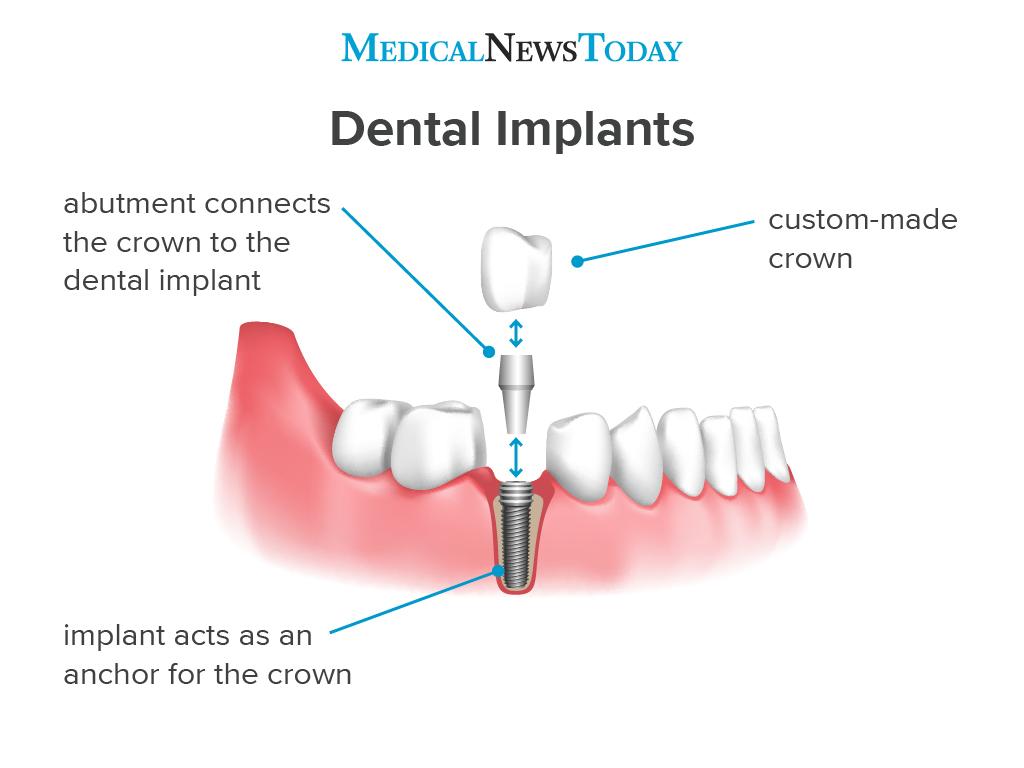The Best Guide To Dental Implants
Table of ContentsThe smart Trick of Dental Implants That Nobody is Talking AboutThe 10-Second Trick For Dental ImplantsThe Greatest Guide To Dental ImplantsSome Known Details About Dental Implants
are clinical tools operatively dental implanted right into the jaw to restore an individual's capability to chew or their appearance. They provide support for synthetic (fake) teeth, such as crowns, bridges, or dentures. When a tooth is lost as a result of injury or illness, an individual can experience problems such as rapid bone loss, defective speech, or modifications to eating patterns that lead to pain.
Structure of The Oral Implant System selecting dental implants, speak to your dental provider regarding the prospective advantages and dangers, and whether you are a prospect for the procedure. Points to consider: Your total health and wellness is an essential consider establishing whether you are a great candidate for oral implants, how much time it will certainly take to recover, and how much time the implant might remain in area.
Cigarette smoking may influence the recovery procedure and decrease the lasting success of the dental implant. The recovery process for the dental implant body may take several months or longer, during which time you usually have a momentary joint in area of the tooth. the oral implant treatment: Thoroughly follow the dental health guidelines provided to you by your dental provider.
Some Known Details About Dental Implants
Implant failing can lead to the demand for an additional medical treatment to take care of or change the dental implant system. Restores the capability to chew Restores cosmetic look Aids keep the jawbone from shrinking due to bone loss Preserves the health and wellness of the surrounding bone and periodontals Assists keep nearby (neighboring) teeth secure Boosts top quality of life Damages to bordering natural teeth during dental implant positioning Injury to the surrounding cells throughout surgical treatment, such as sinus opening Injury during surgery (for instance, crack of surrounding jawbone) Inadequate function, such as really feeling like the teeth do not attack together normally An experience that the tooth hangs or twisting in position arising from an abutment screw loosening Implant body failing (looseness of the implant body) due to systemic infection, which may be most likely in clients with unrestrained diabetics issues because of local infection in bone and gum tissues sustaining the implant body as find more a result of postponed healing, which might be more probable in patients that smoke Problem cleaning up the gums around the dental implant, leading to bad oral hygiene Neglected gum illness Post-surgical numbness because of nerve impingement or damage Constantly notify wellness care suppliers and imaging specialists that you have oral implants before any magnetic vibration imaging (MRI) or x-ray procedures.
FDA is not conscious of any kind of unfavorable occasions reported for MRI or x-ray procedures with oral implants. Oral implants systems are usually made of materials that adhere to international agreement standards of the International Company for Standardization (ISO) or ASTM International. These standards have details of what makes a secure material.
Various other materials such as gold alloys, cobalt-based alloys, titanium alloys, or ceramic products are sometimes utilized. The safety and security accounts of these products are well-known. Dental implant systems are assessed according to worldwide agreement criteria. Biocompatibility screening, to reveal that physical call with the device does not trigger difficulties like irritation or allergy, is component of the evaluation that helps make sure the products in the dental implant system are secure and do not cause unfavorable impacts when dental implanted in individuals.

All about Dental Implants
Some people are not eligible for oral implant surgical procedure. It Click Here is for oral cosmetic surgeons to operate on people with: severe illnessuncontrollable metabolic diseasebone or soft tissue illness or infectionIf these problems are solved, an individual can have the surgical procedure. Dental Implants. In, oral doctors avoid running on individuals with: If individuals with any of the above go through dental implant surgery, there is a higher risk of the dental implant falling short
Some individuals have a jawbone problem that protects against adequate bone for an implant from establishing. In such situations, a cosmetic surgeon may require to execute a ridge alteration. This includes lifting the periodontal to subject the area of flawed bone. The doctor will certainly then use a bone or bone replacement to fix and accumulate the area.
Oral dental implant surgical treatment is a personalized procedure. Give you time to recover. Affix the message and final crown, bridge or denture.
Next off, your specialist will thoroughly place the oral implant into your jaw. Your doctor will reposition your gum tissues and close the cut with stitches (Dental Implants). If your dental implant is near the front of your mouth, your dental practitioner will certainly make a momentary tooth for you to wear until you heal. By doing this, you will not have important site a gap in your smile while you recover.
The Definitive Guide to Dental Implants
Your provider can inform you what to anticipate in your situation. During the recovery stage, your jawbone should fuse to the dental implant. This process, called osseointegration, is vital for stability and long-lasting success. This process can take anywhere from three to nine months. In some cases, it may take much longer.
Once your implant heals, your dental professional can connect the abutment (tiny adapter message) and your final reconstruction (crown, bridge or denture). This usually takes concerning one hour to complete and may call for a 2nd minor surgery. You should not really feel any type of pain throughout your oral implant procedure since your supplier will certainly utilize medication to numb your gum tissues.